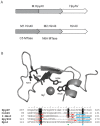Cofactor requirement of HpyAV restriction endonuclease
- PMID: 20140205
- PMCID: PMC2816704
- DOI: 10.1371/journal.pone.0009071
Cofactor requirement of HpyAV restriction endonuclease
Abstract
Background: Helicobacter pylori is the etiologic agent of common gastritis and a risk factor for gastric cancer. It is also one of the richest sources of Type II restriction-modification (R-M) systems in microorganisms.
Principal findings: We have cloned, expressed and purified a new restriction endonuclease HpyAV from H. pylori strain 26695. We determined the HpyAV DNA recognition sequence and cleavage site as CCTTC 6/5. In addition, we found that HpyAV has a unique metal ion requirement: its cleavage activity is higher with transition metal ions than in Mg(++). The special metal ion requirement of HpyAV can be attributed to the presence of a HNH catalytic site similar to ColE9 nuclease instead of the canonical PD-X-D/EXK catalytic site found in many other REases. Site-directed mutagenesis was carried out to verify the catalytic residues of HpyAV. Mutation of the conserved metal-binding Asn311 and His320 to alanine eliminated cleavage activity. HpyAV variant H295A displayed approximately 1% of wt activity.
Conclusions/significance: Some HNH-type endonucleases have unique metal ion cofactor requirement for optimal activities. Homology modeling and site-directed mutagenesis confirmed that HpyAV is a member of the HNH nuclease family. The identification of catalytic residues in HpyAV paved the way for further engineering of the metal binding site. A survey of sequenced microbial genomes uncovered 10 putative R-M systems that show high sequence similarity to the HpyAV system, suggesting lateral transfer of a prototypic HpyAV-like R-M system among these microorganisms.
Conflict of interest statement
Figures




References
Publication types
MeSH terms
Substances
LinkOut - more resources
Full Text Sources
Molecular Biology Databases

